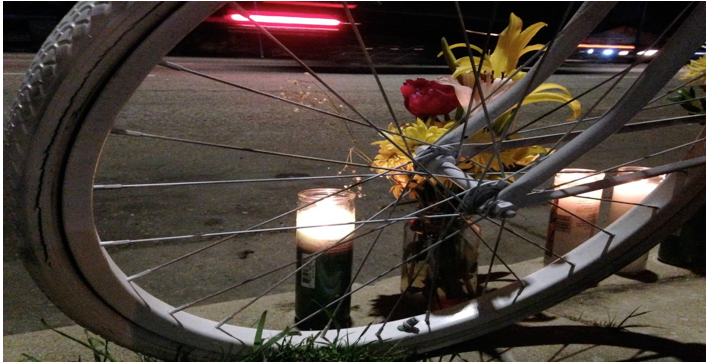CommentsSANE SPEED LIMIT LAWS-Every day we hear about drivers killed in collisions on their way to work or pedestrians mowed down when crossing the street. You may be asking yourself, “Why doesn’t anyone do anything about this? Aren’t there laws to prevent this?” Believe it or not, there are legal obstacles to making our streets safer. We have laws dating back to a more car-centric era that treat pedestrians and cyclists as afterthoughts. If we want active transportation to be accepted by mainstream America, a legal framework will have to evolve to protect all of our road users.
In this series, I will examine legal danger zones and potential fixes for reducing traffic-related deaths in California.
One of the most obvious places to start is speed limits. Since we know conclusively that speed kills, why don’t we set lower speed limits?
A 10 mph reduction in vehicle speed from 40 mph to 30 mph, means that a pedestrian who is hit by a car has just increased his or her chance of survival from 10 to 50 percent.
In Los Angeles, police are unable to ticket speeding drivers for violating the posted speed limit on 75 percent of the city’s streets. Why not? Because the speed surveys required by law for these streets have expired. There is a fear in the active transportation community that the city would be legally required to increase speed limits, further endangering the public, if these speed surveys are conducted.
How did we arrive at such an absurd state of affairs?
California law requires that speed limits be set based on the “prevailing speed.” The prevailing speed is determined by a speed survey which calculates the speed of cars in the 85th percentile. Once this speed of majority drivers is determined, the law only allows an additional 5 mph reduction to account for unforeseen safety conditions. This method of determining the speed limit does not consider the severity of injuries inflicted on a pedestrian or cyclist if hit by a car travelling at the prevailing speed. This needn’t be the case. Alternative speed-setting methods have been effectively used both stateside and overseas.
In countries with the highest rates of bicycle ridership, the severity of injuries caused by crashes at a given speed is taken into account when establishing speed limits. This approach is known as Injury Minimization, or Safe Systems. The idea is to minimize the probability of death and serious injury. It is derived from Sweden’s Vision Zero initiative which dictates that car crashes will occur no matter what; therefore, our road systems ought to be designed to protect us. If we wish to have a larger percentage of people engaging in active transportation, this approach deserves a look.
While the Safe Systems approach started in traditional bike meccas such as the Netherlands and Sweden, the philosophy is gaining traction in other jurisdictions as well. Throughout the United Kingdom, the 20’s Plenty for Us campaign has succeeded in reducing speed limits to 20 mph in more than half of the largest urban areas in Britain. This movement encourages people who walk or bike to use the road system safely. Places adopting the lower speed limits results in more children walking and biking to school.
New York City is the first major urban area in the United States to usher in lower speed limits to reduce death and injury. Thanks to strong advocacy from Transportation Alternatives, Mayor Bill de Blasio signed the 25mph speed limit into law in 2014. Additionally, Oregon and Washington have both passed legislation allowing for 20 mph speed limits.
There is a glimmer of hope for us here in California since there is already an existing exception to the dreaded prevailing speed/85th percentile law: the school zone. This is a legislative exception carved out to protect vulnerable people, namely children. School zones are exempt from the typical speed survey calculations and mandate a 25 mph speed limit when children are present.
What about designating a pedestrian zone? Or an active transportation zone? The same rationale of protecting vulnerable road users could apply. Don’t children who walk to school deserve the same protections as children who are within the school zone?
If Californians want to experience the benefits of lower speed limits, our work is cut out for us. First, we need a fair and enforceable standard for setting speed limits; second, we need a legislator to champion the cause. The Swedish/Dutch Injury Minimization approach is a solid place to start. We can also learn from successful campaigns implemented in the UK and states such as Oregon and Washington.
The challenge of eliminating traffic deaths is great, but the risks of inaction are unconscionable.
(Andrew Said is a prosecutor with the Office of the Los Angeles City Attorney. He focuses on safe streets and active transportation. This piece was provided CityWatch by the author.) Prepped for CityWatch by Linda Abrams.
Sidebar
Our mission is to promote and facilitate civic engagement and neighborhood empowerment, and to hold area government and its politicians accountable.

 CityWatch Los Angeles
Politics. Perspective. Participation.
CityWatch Los Angeles
Politics. Perspective. Participation.
14
Sun, Dec













